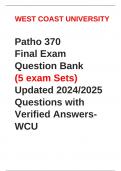WEST COAST UNIVERSITY
Patho 370
Final Exam
Question Bank
(5 exam Sets)
Updated 2024/2025
Questions with
Verified Answers-
WCU
,PATHO 370 FINAL EXAM
Signs and symptoms of ureteral (kidney) stones - Answer flank pain, sweating, nausea,
vomiting, and hematuria
What is the common composition of renal calculi? - Answer calcium crystals
polycystic kidney disease - Answer condition in which the kidney contains many cysts
and is enlarged; the cysts will alter kidney function
glomerulonephritis - Answer inflammation of the glomeruli of the kidney; immune
complex reaction resulting in alterations in the glomerular capillary structure and
function; mediated by IgE
Major sign/symptom of renal cancer - Answer hematuria
What forms renal calculi in patients with gouty arthritis? - Answer uric acid
Acute pyelonephritis - Answer infection of the renal pelvis usually from an ascending
UTI; inflammation that does not result in scarring or fibrosis
What is the common bacteria that causes a UTI? - Answer E. coli
Chronic Pyelonephritis - Answer infection of the renal pelvis that has scarring and
fibrosis and can result in chronic kidney disease; associated with reflux or processes
that lead to urine stasis
clinical manifestations of acute pyelonephritis - Answer CVA tenderness, fever, chills,
nausea, vomiting, anorexia
clinical manifestations of chronic pyelonephritis - Answer abdominal or flank pain, fever,
malaise, anorexia
what are the three phases of tubular necrosis? - Answer prodromal phase, oliguric
phase, post oliguric phase
clinical presentation of the prodromal phase? - Answer normal or declining urine output
& BUN creatinine begin to rise,
,clinical presentation of the oliguric phase? - Answer oliguria, decreased GFR,
hypervolemia (dialysis may be required)
clinical presentation of the postoliguric phase? - Answer postoliguric phase represents
renal recovery; urine volume begins to increase and tubular function begins to improve
fluid volume deficit until kidneys recover
renal osteodystrophy in end-stage renal disease - Answer elevated phosphorus and
PTH causes alterations in the bone and mineral metabolism; kidneys are unable to
reabsorb the calcium and the bones will begin to break down
anemia in end-stage renal disease - Answer kidneys produce erythropoietin, which is
needed to make RBC; a lack of erythropoietin will decrease the RBC count
What are some common causes of CKD? - Answer diabetes and hypertension
What is the cause for acute tubular necrosis? - Answer ischemia leads to acute tubular
necrosis
What are some secondary conditions associated with end-stage chronic renal disease -
Answer anemia, malnutrition, bone and mineral disorders, electrolyte imbalances,
metabolic acidosis, uremic syndrome, hypertension, and cardiovascular disease
what is the most frequent and initial symptom of bladder cancer? - Answer hematuria
What can vesicoureteral reflux lead to? - Answer recurrent cystitis
Who is more prone to UTIs? - Answer sexually active women
ureterocele - Answer cystic dilation of the distal end of the ureter
stress urinary incontinence - Answer urine is involuntarily lost with increases in
intraabdominal pressure; occurs due to a weakening of the pelvic muscles
what are some common causes of stress urinary incontinence? - Answer obesity,
childbirth related trauma, pelvic surgery, diabetes
Urgency Urinary Incontinence - Answer involuntary sudden leakage of urine along with
immediately feeling the need to urinate again; caused by a weakening of the detrusor
muscle
Cystitis - Answer inflammation of the bladder lining
, What are the causes of cystitis? - Answer caused by infection, chemical irritants, stones,
or trauma
What is chryptorchidism a risk factor for? - Answer testicular cancer
chryptorchidism - Answer failure of the testicles to descend into the scrotum
testicular torsion - Answer twisting of the spermatic cord causing decreased blood flow
to the testis and can lead to ischemia making the patient at risk for necrosis
what are the clinical manifestations of testicular torsion? - Answer severe sudden pain
on the testis, swelling of the scrotum, nausea and vomiting
signs and symptoms of prostatic enlargement (BPH) - Answer Prostate tissue increases
and can compress the urethra and bladder outlet causing urinary retention, obstruction
to flow, decreased stream, hesitancy or difficulty initiating stream, interruption of stream,
and infection caused by retention
amenorrhea - Answer absence of menstruation
metrorhagia - Answer bleeding between periods
hypomenorrhea - Answer deficient amount of menstrual flow
oligomenorrhea - Answer infrequent menstruation
polymenorrhea - Answer increased frequency of menstruation
menorrhagia - Answer increased amount and duration of flow
dysfunctional uterine bleeding - Answer Abnormal endometrial bleeding not associated
with tumor, inflammation, pregnancy, trauma, or hormonal effects
dysmenorrhea - Answer painful menstruation
pregnancy induced hypertension - Answer characterized by high blood pressure and
edema along with protein in the urine
hyperemesis gravidarum - Answer severe nausea and vomiting in pregnancy that can
cause severe dehydration in the mother and fetus




